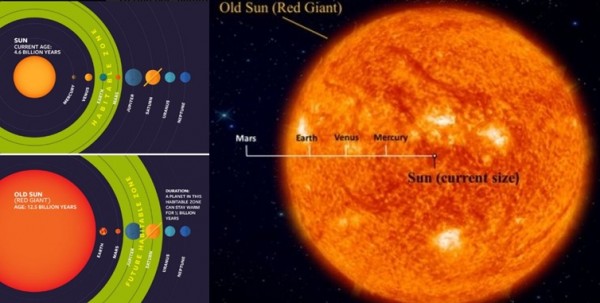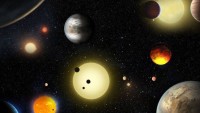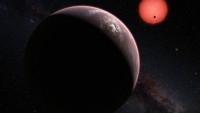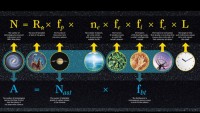Red Giant Dying Stars are Good Candidates for Exoplanets with Alien Life
| Arthur Dominic Villasanta | | May 16, 2016 11:19 PM EDT |
(Photo : Cornell University) The Earth in 5 billion years
Astronomers should devote more attention to exploring massive red giant stars, or old stars about to die, when they hunt for signs of extraterrestrial life, including the search for extraterrestrial intelligence.
This counterintuitive approach in the search for advanced alien intelligence was postulated by a new paper just published in the Astrophysical Journal. In the paper, co-authors Lisa Kaltenegger and Ramses Ramirez drew-up a list of 23 red giant stars within 100 light years of Earth as probable targets for scientists searching for extraterrestrial life.
Like Us on Facebook
"We're basically providing observers with a navigational map of the habitable zone for any star," said Ramirez, a research associate at the Carl Sagan Institute. "It's a tool for finding all potentially habitable planets."
"I hope that this will actually spark an effort by people who look for planets, to also look at these old stars now," said Kaltenegger, an associate professor of astronomy and director of the Carl Sagan Institute.
"Because if you could find signatures of life on such an evolved planet -- a de-frozen planet -- that would tell you that (life) could get started subsurface, and that would be an amazing part of the story."
Their reasons for suggesting a closer focus on red giants is these types of stars might remain capable of supporting life. It can take as long as nine billion years for a red giant to finally explode. Considering the Earth is just 4.5 billion years old, the odds of a red giant with planets capable of supporting alien life - including intelligent life - isn't that farfetched.
The authors pointed to our solar system as an example of this possibility. The solar system's habitable or Goldilocks zone includes only the Earth and Mars. When the sun turns into a red giant some five billion years now, the sun will massively expand and consume both Mercury and Venus.
Because of its close distance to the red giant sun, the Earth will become uninhabitable. The new habitable zone will now include only two planets: Jupiter and Saturn. Scientists are convinced some form of primitive organisms might already be swimming in the frozen seas of the Saturnian moon Enceladus and the Jovian moon Europa.
The study surmises the red giant sun five billion years from now will thaw the ices in the frozen moons and might trigger the same processes that led to the explosion of life on Earth.
Kaltenegger said humans five billion years from now could escape to the moons of Saturn or Jupiter when Earth becomes uninhabitable.
"People keep saying, 'When our sun becomes a big hot star, then we have to move to Mars or other places.' But really for the first time, we have actually calculated where that place is and when," said Kaltenegger.
"If you want to go planet-hopping, you'll want to know when you want to be where, and that's basically what we figured out."
Kaltenegger and Ramirez used models of stars and their evolution that already exist to determine where the habitable zone of a star will move to as the star transforms into a red giant. This made it possible to calculate a star's luminosity and its temperature, which also influences the location of the habitable zone.
TagsEarth, red giant star, Sun, Lisa Kaltenegger, Ramses Ramirez, Astrophysical Journal
©2015 Chinatopix All rights reserved. Do not reproduce without permission
EDITOR'S PICKS
-

Did the Trump administration just announce plans for a trade war with ‘hostile’ China and Russia?
-

US Senate passes Taiwan travel bill slammed by China
-

As Yan Sihong’s family grieves, here are other Chinese students who went missing abroad. Some have never been found
-

Beijing blasts Western critics who ‘smear China’ with the term sharp power
-

China Envoy Seeks to Defuse Tensions With U.S. as a Trade War Brews
-

Singapore's Deputy PM Provides Bitcoin Vote of Confidence Amid China's Blanket Bans
-

China warns investors over risks in overseas virtual currency trading
-

Chinese government most trustworthy: survey
-

Kashima Antlers On Course For Back-To-Back Titles
MOST POPULAR
LATEST NEWS
Zhou Yongkang: China's Former Security Chief Sentenced to Life in Prison

China's former Chief of the Ministry of Public Security, Zhou Yongkang, has been given a life sentence after he was found guilty of abusing his office, bribery and deliberately ... Full Article
TRENDING STORY

China Pork Prices Expected to Stabilize As The Supplies Recover

Elephone P9000 Smartphone is now on Sale on Amazon India

There's a Big Chance Cliffhangers Won't Still Be Resolved When Grey's Anatomy Season 13 Returns

Supreme Court Ruled on Samsung vs Apple Dispute for Patent Infringement

Microsoft Surface Pro 5 Rumors and Release Date: What is the Latest?














